Abstract
We have studied NK cell activity in atopic and non-atopic subjects using a standard 51Cr-release assay and K562 target cells. In atopics (AT) with allergic rhinitis and/or asthma, NK cell activity was similar to that in non-atopic (N) subjects, whilst patients with severe atopic eczema (AE) had depressed NK cell activity compared to AT or N subjects. In addition, circulating T-cell numbers and Con A responsiveness was decreased in AE, although neither parameter was correlated with decreased NK cell activity. However, decreased NK cell activity in atopic eczema was positively correlated with decreased numbers of Fc gamma + lymphocytes (P = 0.01) and decreased effector: target cell binding (P = 0.05), and negatively correlated with increased monocytes in AE (P = 0.09). AE NK cell activity was equally or more sensitive to the inhibitory effects of drugs such as dibutyryl cyclic AMP, prostaglandins (PG) D2,E2 and histamine. The relative percentage increase in NK cell activity by the interferon inducer poly I:C was similar in AE patients and controls. The results suggest that reduced numbers of circulating NK cells and pre-NK cells account for the depressed level of NK cell activity in subjects with severe atopic eczema.
Full text
PDF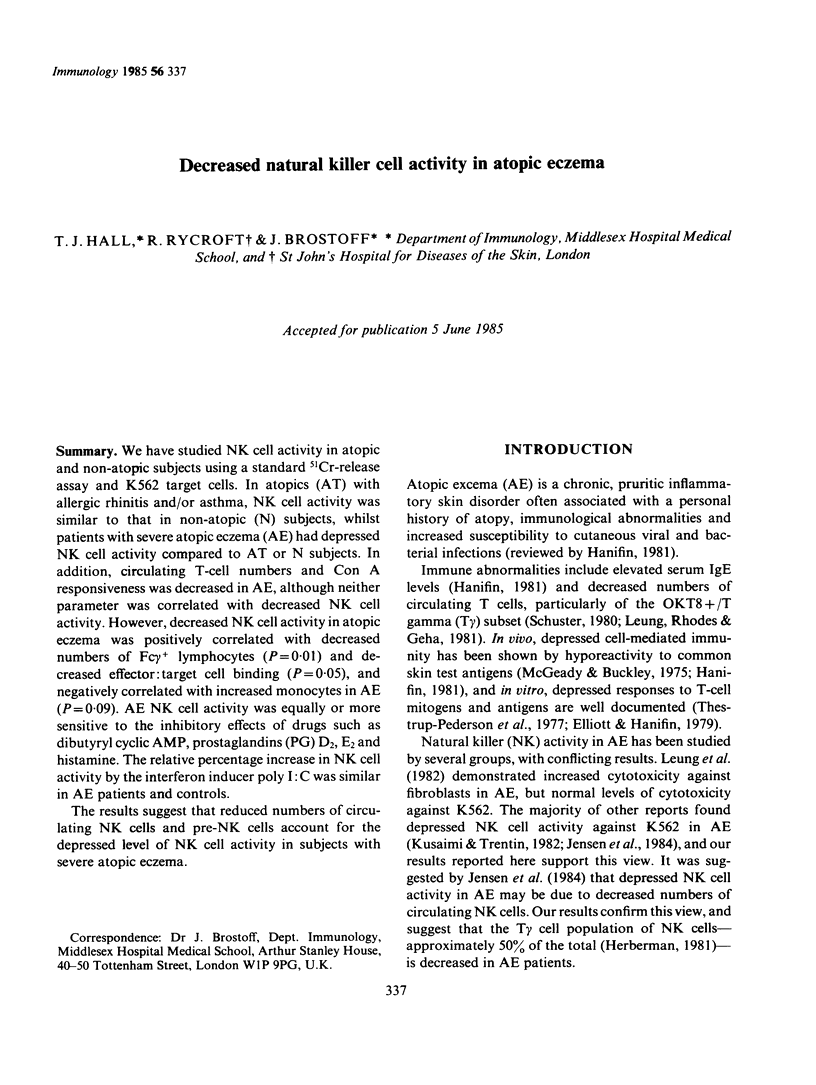
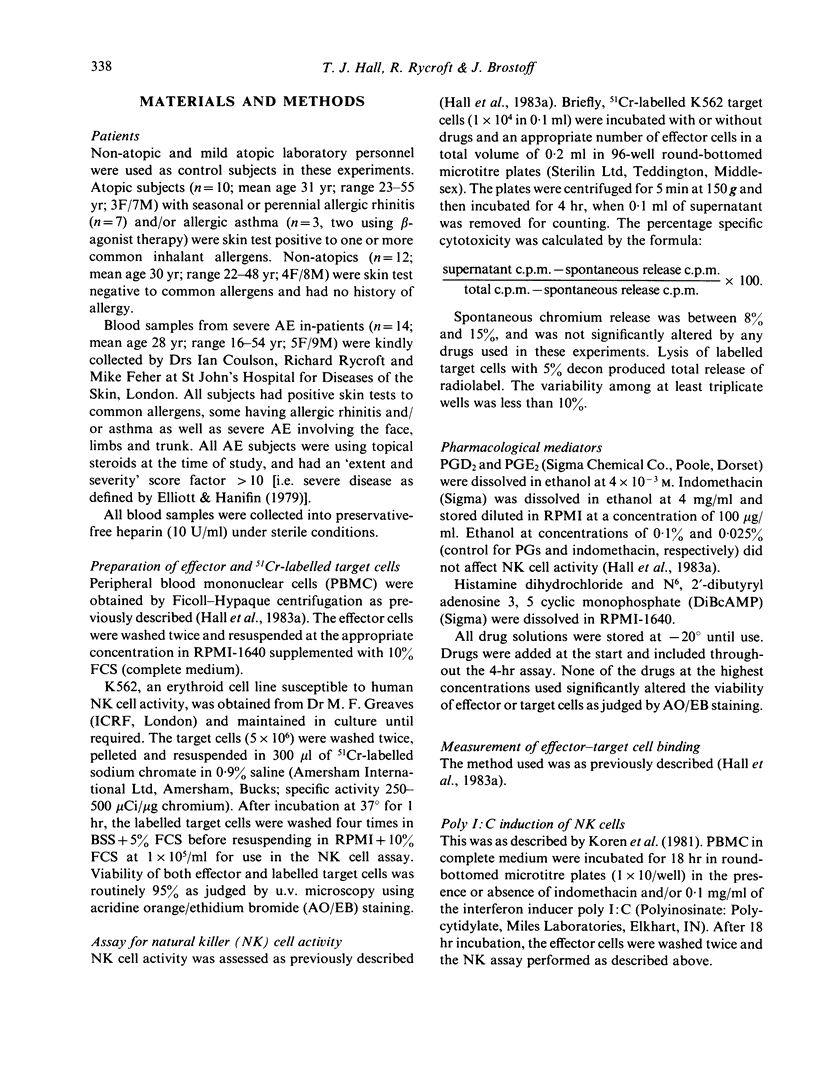
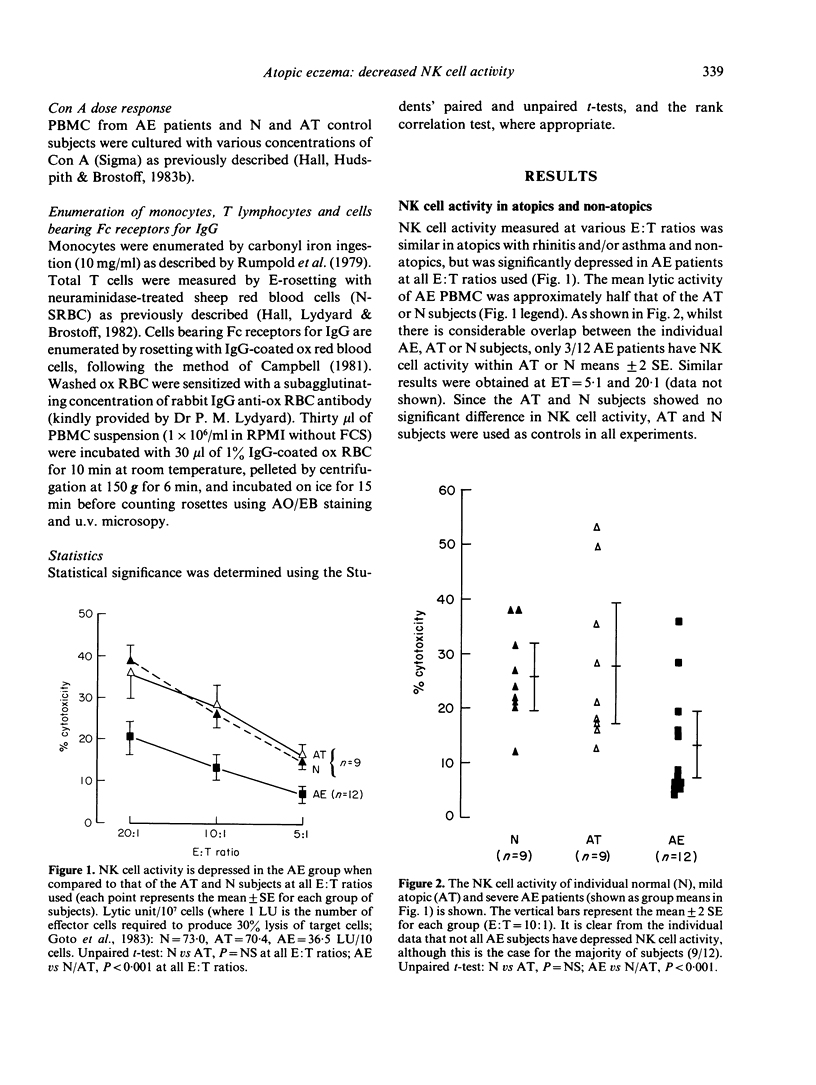
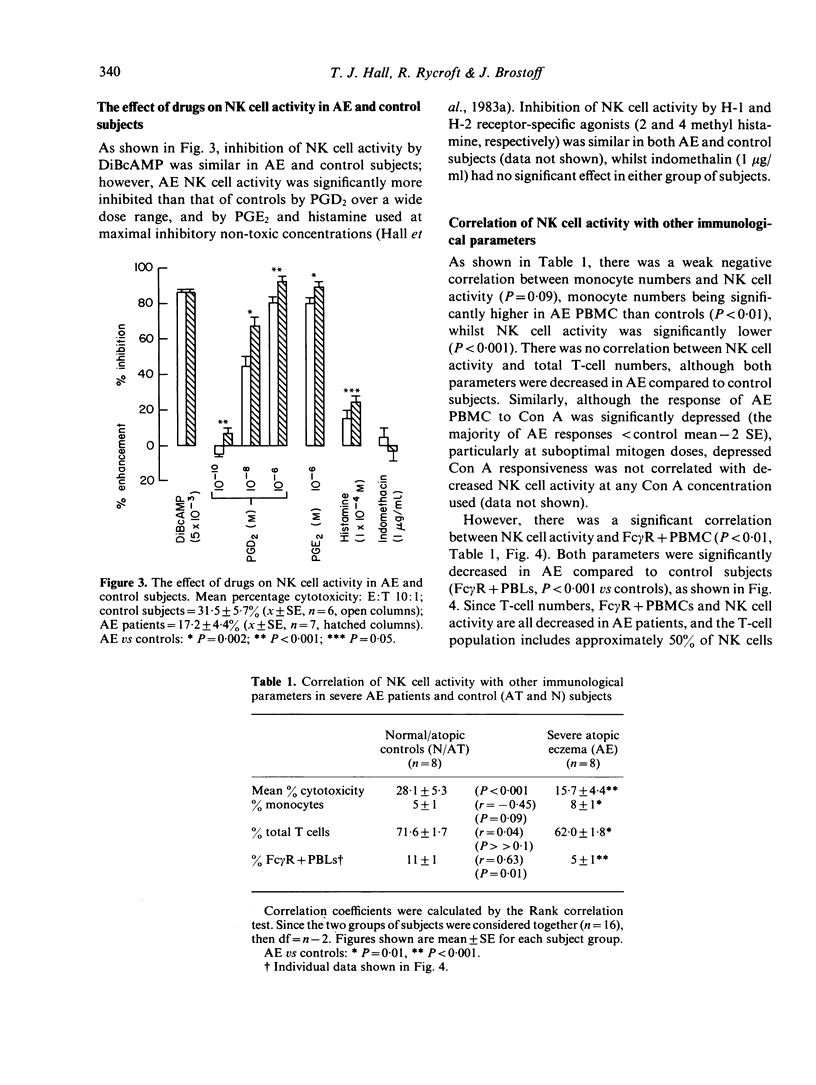

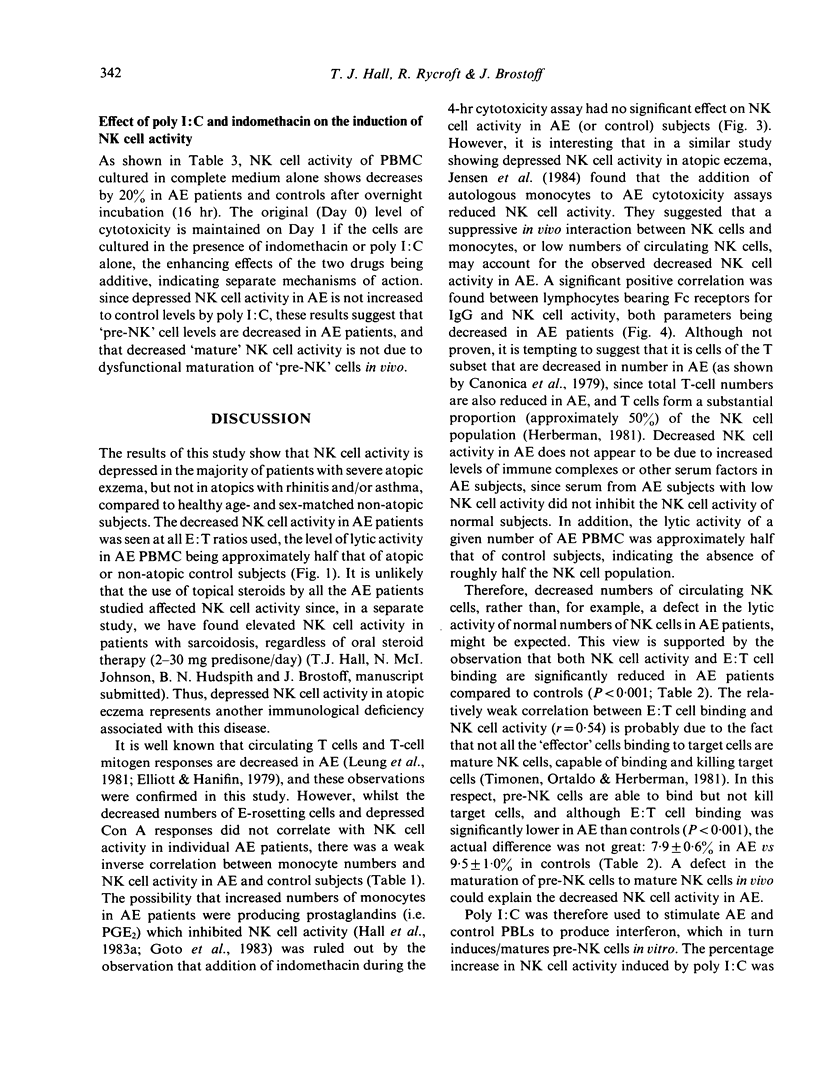
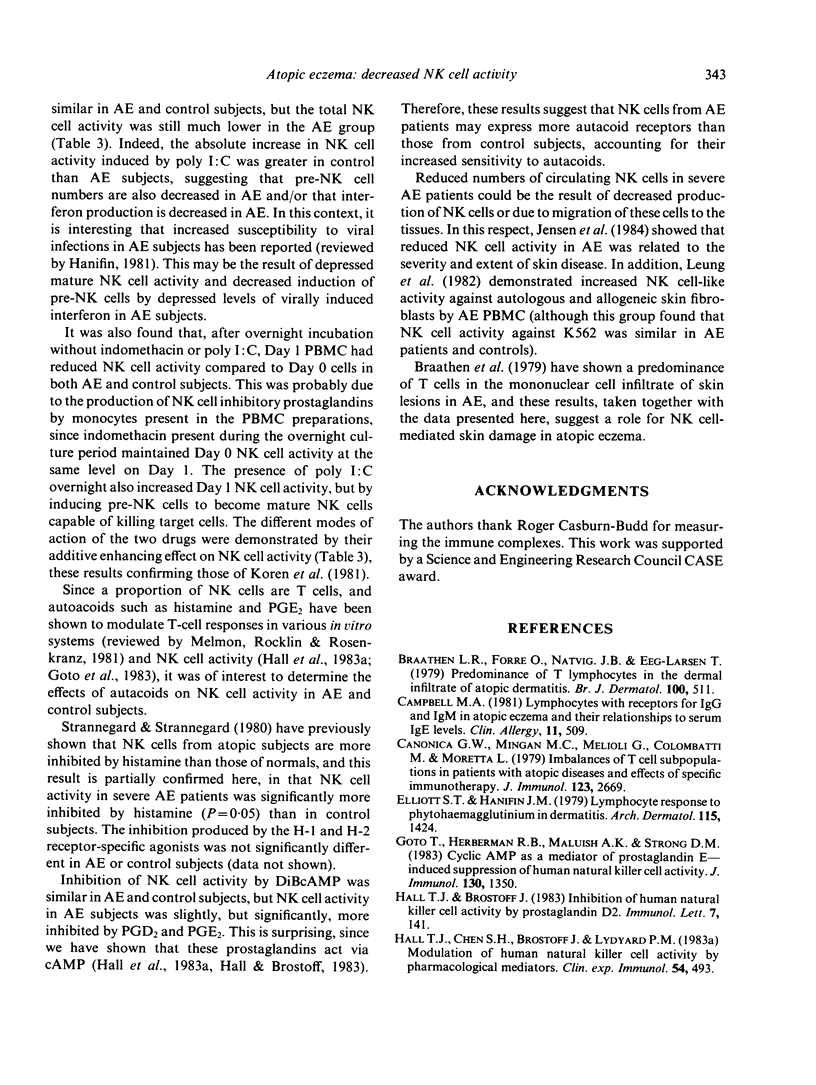
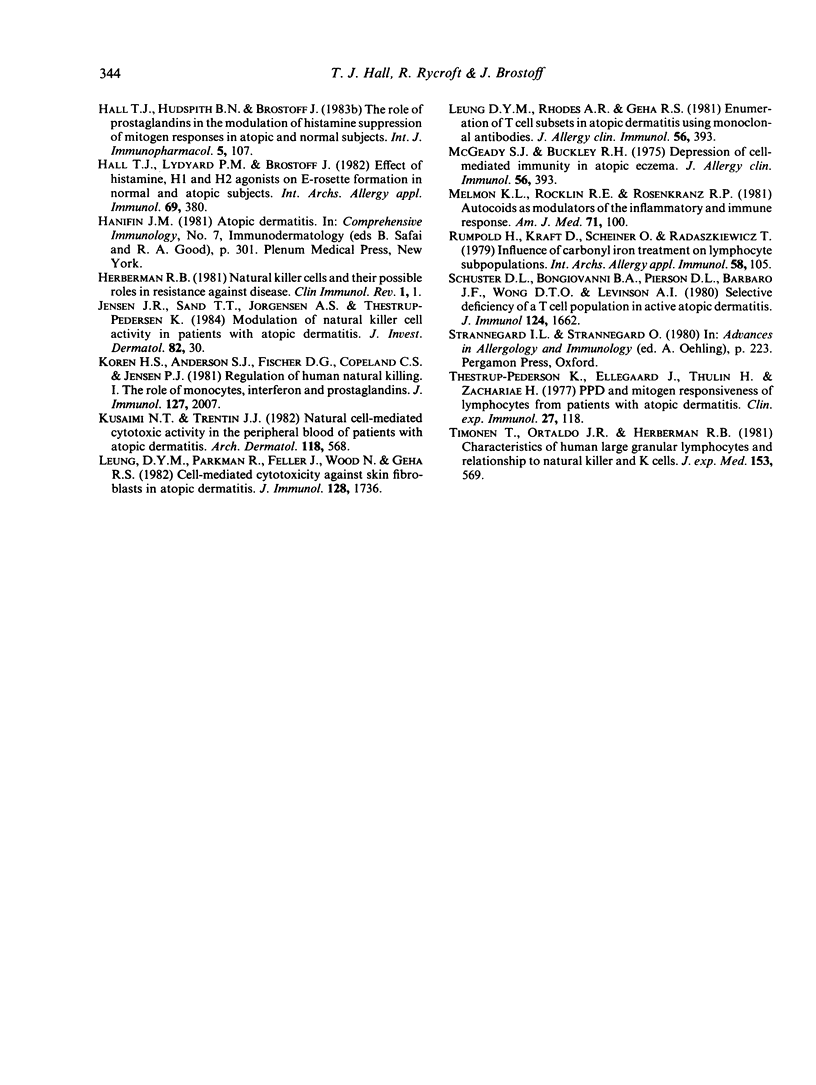
Selected References
These references are in PubMed. This may not be the complete list of references from this article.
- Braathen L. R., Førre O., Natvig J. B., Eeg-Larsen T. Predominance of T lymphocytes in the dermal infiltrate of atopic dermatitis. Br J Dermatol. 1979 May;100(5):511–519. doi: 10.1111/j.1365-2133.1979.tb05576.x. [DOI] [PubMed] [Google Scholar]
- Campbell M. A. Lymphocytes with receptors for IgG and IgM in atopic eczema and their relationship to serum IgE levels. Clin Allergy. 1981 Nov;11(6):509–513. doi: 10.1111/j.1365-2222.1981.tb02168.x. [DOI] [PubMed] [Google Scholar]
- Canonica G. W., Mingari M. C., Melioli G., Colombatti M., Moretta L. Imbalances of T cell subpopulations in patients with atopic diseases and effect of specific immunotherapy. J Immunol. 1979 Dec;123(6):2669–2672. [PubMed] [Google Scholar]
- Elliott S. T., Hanifin J. M. Lymphocyte response to phytohemagglutinin in atopic dermatitis. Arch Dermatol. 1979 Dec;115(12):1424–1426. [PubMed] [Google Scholar]
- Goto T., Herberman R. B., Maluish A., Strong D. M. Cyclic AMP as a mediator of prostaglandin E-induced suppression of human natural killer cell activity. J Immunol. 1983 Mar;130(3):1350–1355. [PubMed] [Google Scholar]
- Hall T. J., Brostoff J. Inhibition of human natural killer cell activity by prostaglandin D2. Immunol Lett. 1983;7(3):141–144. doi: 10.1016/0165-2478(83)90061-5. [DOI] [PubMed] [Google Scholar]
- Hall T. J., Chen S. H., Brostoff J., Lydyard P. M. Modulation of human natural killer cell activity by pharmacological mediators. Clin Exp Immunol. 1983 Nov;54(2):493–500. [PMC free article] [PubMed] [Google Scholar]
- Hall T. J., Hudspith B. N., Brostoff J. The role of prostaglandins in the modulation of histamine suppression of mitogen responses in atopic and normal subjects. Int J Immunopharmacol. 1983;5(2):107–114. doi: 10.1016/0192-0561(83)90001-2. [DOI] [PubMed] [Google Scholar]
- Hall T. J., Lydyard P. M., Brostoff J. Effect of histamine, H1 and H2 agonists on E-rosette formation in normal and atopic subjects. Int Arch Allergy Appl Immunol. 1982;69(4):380–384. doi: 10.1159/000233204. [DOI] [PubMed] [Google Scholar]
- Herberman R. B. Natural killer (NK) cells and their possible roles in resistance against disease. Clin Immunol Rev. 1981;1(1):1–65. [PubMed] [Google Scholar]
- Jensen J. R., Sand T. T., Jørgensen A. S., Thestrup-Pedersen K. Modulation of natural killer cell activity in patients with atopic dermatitis. J Invest Dermatol. 1984 Jan;82(1):30–34. doi: 10.1111/1523-1747.ep12259055. [DOI] [PubMed] [Google Scholar]
- Koren H. S., Anderson S. J., Fischer D. G., Copeland C. S., Jensen P. J. Regulation of human natural killing. I. The role of monocytes, interferon, and prostaglandins. J Immunol. 1981 Nov;127(5):2007–2013. [PubMed] [Google Scholar]
- Kusaimi N. T., Trentin J. J. Natural cell-mediated cytotoxic activity in the peripheral blood of patients with atopic dermatitis. Arch Dermatol. 1982 Aug;118(8):568–571. [PubMed] [Google Scholar]
- Leung D. Y., Parkman R., Feller J., Wood N., Geha R. S. Cell-mediated cytotoxicity against skin fibroblasts in atopic dermatitis. J Immunol. 1982 Apr;128(4):1736–1741. [PubMed] [Google Scholar]
- McGeady S. J., Buckley R. H. Depression of cell-mediated immunity in atopic eczema. J Allergy Clin Immunol. 1975 Nov;56(5):393–406. doi: 10.1016/0091-6749(75)90133-5. [DOI] [PubMed] [Google Scholar]
- Melmon K. L., Rocklin R. E., Rosenkranz R. P. Autacoids as modulators of the inflammatory and immune response. Am J Med. 1981 Jul;71(1):100–106. doi: 10.1016/0002-9343(81)90264-3. [DOI] [PubMed] [Google Scholar]
- Rumpold H., Kraft D., Scheiner O., Radaszkiewicz T. Influence of carbonyl iron treatment on lymphocyte subpopulations. Int Arch Allergy Appl Immunol. 1979;58(1):105–109. doi: 10.1159/000232179. [DOI] [PubMed] [Google Scholar]
- Schuster D. L., Bongiovanni B. A., Pierson D. L., Barbaro J. F., Wong D. T., Levinson A. I. Selective deficiency of a T cell subpopulation in active atopic dermatitis. J Immunol. 1980 Apr;124(4):1662–1667. [PubMed] [Google Scholar]
- Thestrup-Pedersen K., Ellegaard J., Thulin H., Zachariare H. PPD and mitogen responsiveness of lymphocytes from patients with atopic dermatitis. Clin Exp Immunol. 1977 Jan;27(1):118–126. [PMC free article] [PubMed] [Google Scholar]
- Timonen T., Ortaldo J. R., Herberman R. B. Characteristics of human large granular lymphocytes and relationship to natural killer and K cells. J Exp Med. 1981 Mar 1;153(3):569–582. doi: 10.1084/jem.153.3.569. [DOI] [PMC free article] [PubMed] [Google Scholar]


